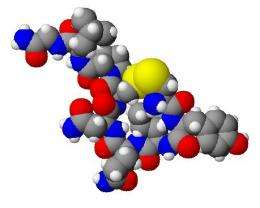Oxytocin strengthens mothers' neural responses to infant and adult faces

In a new study from the University of Tampere in Finland, nasally administered oxytocin spray strengthened brain responses to pictures of infant and adult faces in mothers of one-year-old infants. Oxytocin is a hormone and a neuropeptide that plays an important role in inducing labor, lactation, and caregiving behaviors in mammals. The influence of oxytocin on the perception of faces, emotions, and other social information has been widely studied in recent years by administering oxytocin with a nasal spray. Studies have shown, for example, that intranasal oxytocin administration may increase emotion recognition and brain activity during face perception.
Oxytocin appears to have an important role in processing social information and maintaining social bonds. Some researchers have even suggested that in the future, oxytocin might be used to overcome problems in early parent-infant interaction, but there have been surprisingly few studies that test the effects of intranasal oxytocin in mothers of young children.
The new study investigated whether oxytocin nasal spray has an effect on the neural responses to faces in mothers of one-year-old infants. Given the role of oxytocin in early caregiving behaviors, the specific goal of the study was to explore whether the effects of oxytocin are more pronounced in response to infant faces. Brain responses were measured with electroencephalography (EEG), which provides information on the early stages of visual perception.
The participants were 52 Finnish mothers of one-year-old infants. During two laboratory visits, the researchers used EEG to measure the mothers' neural responses to infant and adult faces. Before each measurement, the mothers were administered either a placebo or an oxytocin nasal spray. A double-blind study design ensured that neither the mothers nor the researchers knew which spray was administered.
The analysis showed that oxytocin increased the so-called N170 component of the EEG signal in response to infant and adult faces. The N170 component reflects activation of brain areas sensitive to faces, indicating that faces activated these areas more strongly after being administered oxytocin. The results did not clearly show whether the effects of oxytocin were larger in response to infant faces than to adult faces.
"The main contribution of this study was to expand experimental oxytocin research to the mothers of young children who have rarely been included in this type of studies," says Academy Research Fellow Mikko Peltola from the University of Tampere.
"In the future, it will be important to conduct research with larger samples in order to determine whether oxytocin specifically affects sensitivity to infant signals because that is one of the key aspects of parenting," says Professor Kaija Puura from the University of Tampere and Tampere University Hospital.
More information: Mikko J. Peltola et al, Oxytocin promotes face-sensitive neural responses to infant and adult faces in mothers, Psychoneuroendocrinology (2018). DOI: 10.1016/j.psyneuen.2018.02.012




















